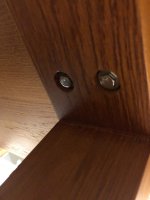Thanks all again for your replies. My mate is also watching this thread  , so hopefully he can get some ideas here.
, so hopefully he can get some ideas here.
I had also asked about the base prior to posting and here are the photos for those who are as curious as I am:
View attachment 1
View attachment 2
I can't tell if the holes for the bolts into the top are elongated or oversized to allow for movement, but he had been advised to "not tighten too much" (which doesn't really say much at all).
I had also asked about the base prior to posting and here are the photos for those who are as curious as I am:
View attachment 1
View attachment 2
I can't tell if the holes for the bolts into the top are elongated or oversized to allow for movement, but he had been advised to "not tighten too much" (which doesn't really say much at all).


